VueJS过渡和动画
在本章中,我们将讨论VueJS中可用的过渡和动画功能。
过渡
当在DOM中添加/更新HTML元素时,VueJS提供了各种方法来将过渡应用于HTML元素。 VueJS具有内置的过渡组件,需要将其包装在需要过渡的元素周围。
语法
<transition name = "nameoftransition"> <div></div> </transition>
让我们考虑一个示例,以了解过渡的工作原理。
<html>
<head>
<title>VueJs Instance</title>
<script type = "text/javascript" src = "js/vue.js"></script>
</head>
<body>
<style>
.fade-enter-active, .fade-leave-active {
transition: opacity 2s
}
.fade-enter, .fade-leave-to /* .fade-leave-active below version 2.1.8 */ {
opacity: 0
}
</style>
<div id = "databinding">
<button v-on:click = "show = !show">Click Me</button>
<transition name = "fade">
<p v-show = "show" v-bind:style = "styleobj">Animation Example</p>
</transition>
</div>
<script type = "text/javascript">
var vm = new Vue({
el: '#databinding',
data: {
show:true,
styleobj :{
fontSize:'30px',
color:'red'
}
},
methods : {
}
});
</script>
</body>
</html>
创建了一个名为clickme的按钮,使用该按钮可以将变量show的值从true更改为false,反之亦然。有一个 p tag 仅当变量为true时才显示文本元素。我们已经用过渡元素包装了p标签,如下面的代码所示。
<transition name = "fade"> <p v-show = "show" v-bind:style = "styleobj">Animation Example</p> </transition>
过渡的名称是 fade 。 VueJS提供了一些用于过渡的标准类,并且这些类的前缀是过渡的名称。
以下是一些过渡的标准类:
-
v-enter :在元素被更新/添加之前,最初会调用此类。它的起始状态。
-
主动 :此类用于定义进入过渡阶段的延迟,持续时间和缓动曲线。这是整个活动状态,并且在整个进入阶段都可以使用该类。
-
v-leave :触发离开过渡时添加,删除。
-
主动离开 :在离开阶段使用。过渡完成后将其删除。此类用于在离开阶段应用延迟,持续时间和缓动曲线。
以上每个类都将以过渡名称作为前缀。我们将过渡的名称设置为淡入淡出,因此类的名称变为 .fade_enter,.fade_enter_active,.fade_leave,.fade_leave_active .
它们在以下代码中定义。
<style>
.fade-enter-active, .fade-leave-active {
transition: opacity 2s
}
.fade-enter, .fade-leave-to /* .fade-leave-active below version 2.1.8 */ {
opacity: 0
}
</style>
.fade_enter_active和.fade_leave_active一起定义,并且在开始和离开阶段应用过渡。 opacity属性在2秒内更改为0。
持续时间在.fade_enter_active和.fade_leave_active中定义。最后阶段在.fade_enter,.fade_leave_to中定义。
浏览器中的显示如下。

单击该按钮,文本将在两秒钟内消失。

两秒钟后,文本将完全消失。
让我们考虑另一个示例,其中有一个图像,并且在单击按钮时它在x轴上移动。
<html>
<head>
<title>VueJs Instance</title>
<script type = "text/javascript" src = "js/vue.js"></script>
</head>
<body>
<style>
.shiftx-enter-active, .shiftx-leave-active {
transition: all 2s ease-in-out;
}
.shiftx-enter, .shiftx-leave-to /* .fade-leave-active below version 2.1.8 */ {
transform : translateX(100px);
}
</style>
<div id = "databinding">
<button v-on:click = "show = !show">Click Me</button>
<transition name = "shiftx">
<p v-show = "show">
<img src = "images/img.jpg" style = "width:100px;height:100px;" />
</p>
</transition>
</div>
<script type = "text/javascript">
var vm = new Vue({
el: '#databinding',
data: {
show:true
},
methods : {
}
});
</script>
</body>
</html>
过渡的名称是 shiftx 。使用以下代码段,可以使用transform属性将x轴上的图像移动100px。
<style>
.shiftx-enter-active, .shiftx-leave-active {
transition: all 2s ease-in-out;
}
.shiftx-enter, .shiftx-leave-to /* .fade-leave-active below version 2.1.8 */ {
transform : translateX(100px);
}
</style>
以下是输出。
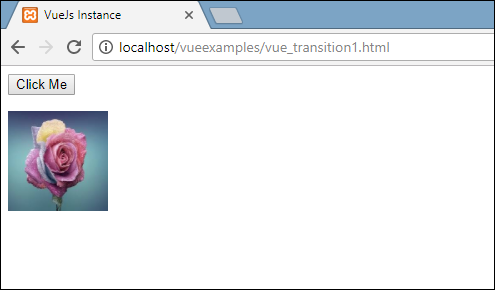
单击按钮后,图像将向右移动100px,如以下屏幕截图所示。
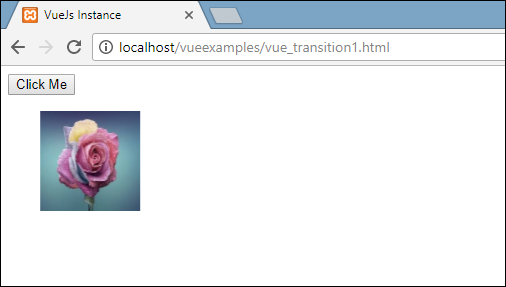
动画片
动画的应用与完成过渡的方式相同。动画还具有需要声明的类才能产生效果。
让我们考虑一个示例,以查看动画的工作原理。
<html>
<head>
<title>VueJs Instance</title>
<script type = "text/javascript" src = "js/vue.js"></script>
</head>
<body>
<style>
.shiftx-enter-active {
animation: shift-in 2s;
}
.shiftx-leave-active {
animation: shift-in 2s reverse;
}
@keyframes shift-in {
0% {transform:rotateX(0deg);}
25% {transform:rotateX(90deg);}
50% {transform:rotateX(120deg);}
75% {transform:rotateX(180deg);}
100% {transform:rotateX(360deg);}
}
</style>
<div id = "databinding">
<button v-on:click = "show = !show">Click Me</button>
<transition name = "shiftx">
<p v-show = "show">
<img src = "images/img.jpg" style = "width:100px;height:100px;" />
</p>
</transition>
</div>
<script type = "text/javascript">
var vm = new Vue({
el: '#databinding',
data: {
show:true
},
methods : {
}
});
</script>
</body>
</html>
要应用动画,有与过渡相同的类。在上面的代码中,我们在p标记中包含了一个图像,如以下代码所示。
<transition name = "shiftx"> <p v-show = "show"><img src = "images/img.jpg" style = "width:100px;height:100px;" /></p> </transition>
过渡的名称是 shiftx 。适用的课程如下:
<style>
.shiftx-enter-active {
animation: shift-in 2s;
}
.shiftx-leave-active {
animation: shift-in 2s reverse;
}
@keyframes shift-in {
0% {transform:rotateX(0deg);}
25% {transform:rotateX(90deg);}
50% {transform:rotateX(120deg);}
75% {transform:rotateX(180deg);}
100% {transform:rotateX(360deg);}
}
</style>
该类的前缀为过渡名称,即shiftx-enter-active和.shiftx-leave-active。动画是使用0%到100%的关键帧定义的。在每个关键帧处定义了一个转换,如以下代码所示。
@keyframes shift-in {
0% {transform:rotateX(0deg);}
25% {transform:rotateX(90deg);}
50% {transform:rotateX(120deg);}
75% {transform:rotateX(180deg);}
100% {transform:rotateX(360deg);}
}
以下是输出。

单击该按钮时,它会从0旋转到360度,然后消失。
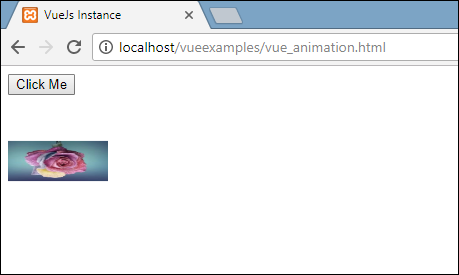
自定义过渡类
VueJS提供了一系列自定义类,可以将它们作为属性添加到过渡元素中。
- 进阶
- 主动活动班
- 休假
- 休假班
当我们想使用外部CSS库(例如animate.css)时,自定义类基本上会发挥作用。
<html>
<head>
<link href = "https:// cdn.jsdelivr.net/npm/animate.css@3.5.1“ rel =” stylesheet“ type =” text / css“>
<script type = "text/javascript" src = "js/vue.js"></script>
</head>
<body>
<div id = "animate" style = "text-align:center">
<button @click = "show = !show"><span style = "font-size:25px;">Animate</span></button>
<transition
name = "custom-classes-transition"
enter-active-class = "animated swing"
leave-active-class = "animated bounceIn">
<p v-if = "show"><span style = "font-size:25px;">Example</span></p>
</transition>
</div>
<script type = "text/javascript">
var vm = new Vue({
el: '#animate',
data: {
show: true
}
});
</script>
</body>
</html>

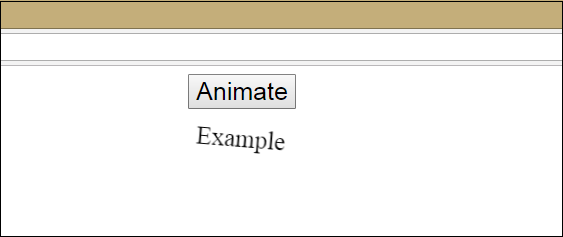
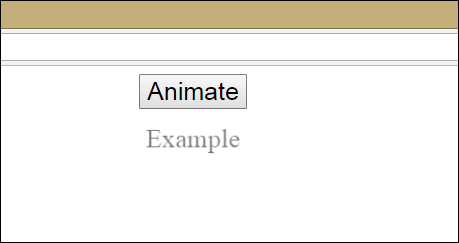
上面的代码中应用了两个动画。一个enter-active-class =“动画挥杆”,另一个leave-active-class =“动画bounceIn”。我们正在将自定义动画类用于要从第三方库中应用的动画。
显式过渡持续时间
我们可以使用VueJS在元素上应用过渡和动画。 Vue等待transionend和animationend事件检测动画或过渡是否完成。
有时过渡可能会导致延迟。在这种情况下,我们可以如下明确地应用持续时间。
<transition :duration = "1000"></transition>
<transition :duration = "{ enter: 500, leave: 800 }">...</transition>
我们可以将duration属性与过渡元素上的:一起使用,如上所示。如果需要分别指定进入和离开的持续时间,可以按照上面的代码所示进行。
JavaScript挂钩
可以将过渡类称为使用JavaScript事件的方法。让我们考虑一个更好理解的例子。
<html>
<head>
<title>VueJs Instance</title>
<script type = "text/javascript" src = "js/vue.js"></script>
</head>
<body>
<script src = "https:// cdnjs.cloudflare.com/ajax/libs/velocity/1.2.3/velocity.min.js“>
<div id = "example-4">
<button @click = "show = !show">
<span style = "font-size:25px;">Toggle</span>
</button>
<transition v-on:before-enter = "beforeEnter"
v-on:enter = "enter"
v-on:leave = "leave"
v-bind:css = "false">
<p v-if = "show" style = "font-size:25px;">Animation Example with velocity</p>
</transition>
</div>
<script type = "text/javascript">
var vm = new Vue({
el: '#example-4',
data: {
show: false
},
methods: {
beforeEnter: function (el) {
el.style.opacity = 0
},
enter: function (el, done) {
Velocity(el, { opacity: 1, fontSize: '25px' }, { duration: 1000 })
Velocity(el, { fontSize: '10px' }, { complete: done })
},
leave: function (el, done) {
Velocity(el, { translateX: '15px', rotateZ: '50deg' }, { duration: 1500 })
Velocity(el, { rotateZ: '100deg' }, { loop: 2 })
Velocity(el, {
rotateZ: '45deg',
translateY: '30px',
translateX: '30px',
opacity: 0
}, { complete: done })
}
}
});
</script>
</body>
</html>

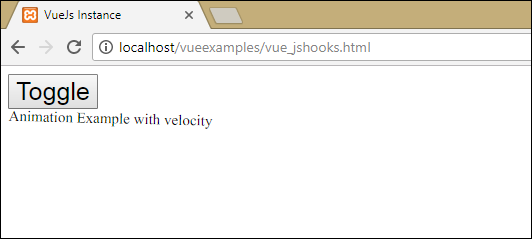
在上面的示例中,我们在过渡元素上使用js方法执行动画。
过渡方法如下:
<transition v-on:before-enter = "beforeEnter" v-on:enter = "enter" v-on:leave = "leave" v-bind:css = "false"> <p v-if = "show" style = "font-size:25px;">Animation Example with velocity</p> </transition>
添加了前缀 v-on 以及调用该方法的事件的名称。这些方法在Vue实例中定义如下:
methods: {
beforeEnter: function (el) {
el.style.opacity = 0
},
enter: function (el, done) {
Velocity(el, { opacity: 1, fontSize: '25px' }, { duration: 1000 })
Velocity(el, { fontSize: '10px' }, { complete: done })
},
leave: function (el, done) {
Velocity(el, { translateX: '15px', rotateZ: '50deg' }, { duration: 1500 })
Velocity(el, { rotateZ: '100deg' }, { loop: 2 })
Velocity(el, {
rotateZ: '45deg',
translateY: '30px',
translateX: '30px',
opacity: 0
}, { complete: done })
}
}
在每种方法中都将应用所需的转换。单击按钮时以及完成动画后,都会应用不透明度动画。第三方库用于动画。
在过渡v-bind:css =“ false”上添加了一个属性,这样做是为了使Vue理解这是一个JavaScript过渡。
初始渲染时的过渡
为了在开始时添加动画,我们需要在过渡元素中添加“ appear”属性。
让我们看一个例子,以更好地理解它。
<html>
<head>
<link href = "https:// cdn.jsdelivr.net/npm/animate.css@3.5.1“ rel =” stylesheet“ type =” text / css“>
<script type = "text/javascript" src = "js/vue.js"></script>
</head>
<body>
<div id = "animate" style = "text-align:center">
<transition
appear
appear-class = "custom-appear-class"
appear-active-class = "animated bounceIn">
<h1>BounceIn - Animation Example</h1>
</transition>
<transition
appear
appear-class = "custom-appear-class"
appear-active-class = "animated swing">
<h1>Swing - Animation Example</h1>
</transition>
<transition
appear
appear-class = "custom-appear-class"
appear-active-class = "animated rubberBand">
<h1>RubberBand - Animation Example</h1>
</transition>
</div>
<script type = "text/javascript">
var vm = new Vue({
el: '#animate',
data: {
show: true
}
});
</script>
</body>
</html>
在上面的示例中,我们使用了animate.css库中的三种不同的动画。我们在过渡元素中添加了外观。
执行以上代码后,浏览器中将输出以下内容。

组件动画
我们可以使用以下代码包装组件的过渡。我们在这里使用了动态组件。
<html>
<head>
<title>VueJs Instance</title>
<script type = "text/javascript" src = "js/vue.js"></script>
<link href = "https:// cdn.jsdelivr.net/npm/animate.css@3.5.1“ rel =” stylesheet“ type =” text / css“>
</head>
<body>
<div id = "databinding" style = "text-align:center;">
<transition appear
appear-class = "custom-appear-class"
appear-active-class = "animated wobble">
<component v-bind:is = "view"></component>
</transition>
</div>
<script type = "text/javascript">
var vm = new Vue({
el: '#databinding',
data: {
view: 'component1'
},
components: {
'component1': {
template: '<div><span style = "font-
size:25;color:red;">Animation on Components</span></div>'
}
}
});
</script>
</body>
</html>

